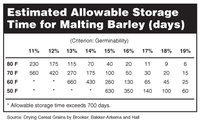Malting Barley Requires Special Care When Drying
(Click the image below to view a high-resolution image that can be downloaded)
Malting barley germination will be lost if adequate airflow is not provided to barley being dried by natural air or low-temperature drying so that it is dried within the allowable storage time, according to Ken Hellevang, North Dakota State University Extension Service agricultural engineer and grain-drying expert.
Minimum recommended airflow rates and drying times to dry the barley within the allowable storage time are 1.25 cubic feet per minute per bushel (cfm/bu) to dry 18 percent moisture barley in about 20 days and 0.75 cfm/bu to dry up to 17 percent moisture barley in about 31 days, based on typical August weather conditions.
“Drying occurs in a zone that moves from the bottom of the bin to the top if the air is pushed up through the barley,” Hellevang says. “Grain at the top will stay near the initial moisture content until the drying zone reaches the top of the grain, so adequate airflow to dry the barley within its allowable storage time is critical.”
Use a fan selection program or table, such as one available from the NDSU Extension Service, to determine whether you have adequate airflow. For more information, go to NDSU’s grain drying, handling and storage Web site at http://www.ag.ndsu.nodak.edu/abeng/postharvest.htm. You also can have the fan supplier verify the airflow rate.
The allowable storage time (or drying time) is related to the grain temperature and moisture content. The allowable storage time based on germination is about 20 days for 18 percent moisture barley at 70 F, 30 days at 17 percent and 50 days at 16 percent. Germination will be lost before mold growth is visible.
Both the time required to complete drying and the allowable storage time will be longer at cooler temperatures because the cooler air holds less moisture. Drying grain at 60 degrees will take about 30 percent longer than it does at 70 degrees. Drying 17 percent moisture barley will take about 40 days with an airflow rate of 0.75 cfm/bu at 60 degrees, which is about 1.3 times longer than the 31 days at 70 degrees. The allowable storage time for 17 percent moisture barley is about 65 days at 60 degrees, or about twice as long as the 30 days at 70 degrees.
Adding supplemental heat to a natural-air drying system will reduce the moisture content of the grain but only reduces the drying time slightly. Warming the air by 5 degrees will reduce the relative humidity by about 10 percent and the barley moisture content by about 1.5 percentage points. The air normally will be warmed 3 to 5 degrees by the fan operating at a static pressure of about 5 to 6 inches associated with drying barley, so, typically, little additional heat is needed.
Adding more heat than is required results in the barley being dried to a moisture content lower than desired. The equilibrium moisture content for barley is about 12 percent at 70 F and 60 percent relative humidity, which are average conditions for August. September air conditions of 58 F and 70 percent relative humidity will be 63 F and 60 percent relative humidity if the fan heats the air 5 degrees. This air will dry barley to about 12 percent moisture content.
Hellevang also recommends limiting the plenum temperature in a high-temperature dryer to a maximum of 110 F when drying malting barley to maintain germination.
NDSU Agriculture Communication
| Source: | Ken Hellevang, (701) 231-7243, kenneth.hellevang@ndsu.edu |
|---|---|
| Editor: | Ellen Crawford, (701) 231-5391, ellen.crawford@ndsu.edu |


